The Santonian is an age in the geologic timescale or a chronostratigraphic stage. It is a subdivision of the Late Cretaceous Epoch or Upper Cretaceous Series. It spans the time between 86.3 ± 0.7 mya and 83.6 ± 0.7 mya. The Santonian is preceded by the Coniacian and is followed by the Campanian.
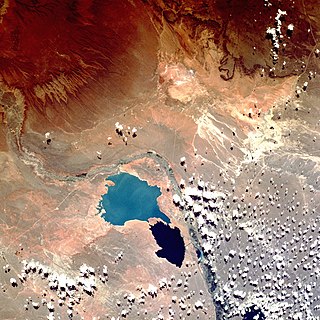
The Neuquén Group is a group of geologic formations found in Argentina. Rocks in the Neuquén Group fall within the Cenomanian to early Campanian stages of the Late Cretaceous Period. It overlies the older Lohan Cura Formation and is itself overlain by the younger Allen Formation of the Malargüe Group, separated from both by unconformities, dated to 98 and 79 Ma respectively.
Austiniceras is a subgenus of Parapuzosia, the shell of which is commonly large, moderately involute, high whorled, with flat or convex sides that converge on a narrowly rounded venter. Primary ribs are sigmoid or concave. Constrictions where present are rather shallow. The related subgenus P. (Parapuzosia) differs in having a more oval whorl section, stronger and straighter primary ribs, and a smooth outer whorl.
Karapadites is an extinct ammonoid genus belonging to the desmoceratacean family Kossmaticeratidae and considered by some to be a subgenus of Kossmaticeras.

Anapachydiscus is an extinct cephalopod genus from the Upper Cretaceous, Santonian - Maastrichtian of Europe, Africa, Madagascar, S.India, N Z, Calif. Mexico, Argentina, and the Antarctic belonging to the ammonoid family Pachydiscidae.
Aegoceras (Beaniceras) is small, coarsely ribbed subgenus ammonite from the Lower Jurassic with coarsely ribbed rounded whorls. The shell is evolute, early whorls a barrel-shaped cadicone, later become serpenticonic.

Littorina sitkana is a species of small sea snail, a marine gastropod mollusc in the family Littorinidae, the winkles. It is commonly found in the high tidal zone and the splash zone.

Parahesperornis is a genus of prehistoric flightless birds from the Late Cretaceous. Its range in space and time may have been extensive, but its remains are rather few and far between, at least compared with its contemporary relatives in Hesperornis. Remains are known from central North America, namely the former shallows of the Western Interior Seaway in Kansas. Found only in the upper Niobrara Chalk, these are from around the Coniacian-Santonian boundary, 85–82 million years ago (mya).

Nostoceras is an extinct genus of ammonites. The etymology of the name Nostoceras comes from "nostos" meaning return and "ceros" meaning horn, named as such by Alpheus Hyatt because it bends back on itself.
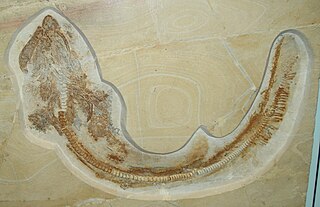
Paraorthacodus is an extinct genus of shark. It a member of the family Paraorthacodontidae, which is either placed in Hexanchiformes or in Synechodontiformes. It is known from over a dozen named species spanning from the Early Jurassic to the Paleocene, or possibly Eocene. Almost all members of the genus are exclusively known from isolated teeth, with the exception of P. jurensis from the Late Jurassic-Early Cretaceous of Europe, which is known from full body fossils from the Late Jurassic of Germany, which suggest that juveniles had a robust body with a round head, while adults had large body sizes with a fusiform profile. There was only a single dorsal fin towards the back of the body without a fin spine. The dentition had teeth with a single large central cusp along with shorter lateral cusplets, which were designed for clutching. The teeth are distinguished from those of Synechodus by the lateral cusplets decreasing in size linearly away from the central cusp rather than exponentially as in Synechodus.
Xixianykus is a genus of alvarezsaurid theropod dinosaur from the late Cretaceous period of China. Known from a slab of rock which contains a partial postcranial skeleton unearthed in the Late Cretaceous (Coniacian-Santonian) Majiacun Formation of the Xixia Basin in Henan, China.

Comitas paupera is a species of sea snail, a marine gastropod mollusk in the family Pseudomelatomidae.
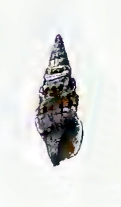
Crassispira flavonodulosa is a species of sea snail, a marine gastropod mollusk in the family Pseudomelatomidae.
Veprecula brunonia is a species of sea snail, a marine gastropod mollusk in the family Raphitomidae.

Forresteria is an extinct genus of cephalopod belonging to the subclass Ammonoidea. They flourished during the late Turonian and early Santonian of the Late Cretaceous, and were global in extent. Forresteria alluaudi and Forresteria hobsoni are considered marker fossils for the lower Coniacian in the American West.

Macrocephalites is a genus of the stephanoceratoid ammonite family Macrocephalitidae, diagnostic of the Callovian stage of the Middle Jurassic. Three subgenera, Dolikephalites, Kamptokephalites, and Pleurocephalites are recognized in addition to Macrocephalites itself, with Indocephalites tentatively included as the fourth.
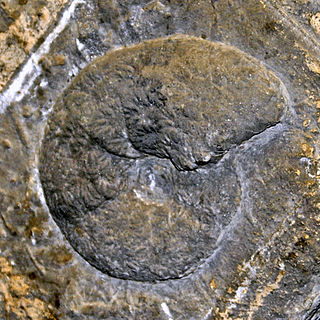
Pachydiscidae is a family of middle and upper Cretaceous ammonites in the superfamily Desmoceratoidea.
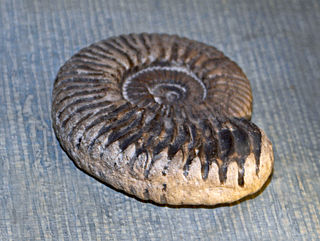
The Peltoceratinae comprise a subfamily in the Aspidoceratidae,.
Dipoloceras is a rather evolute, strongly ribbed and well keeled acanthocerataean ammonite from the Albian stage of the Lower Cretaceous included in the brancoceratid subfamily Mojsisovicziinae. The whorl section is typically inflated or depressed. Ribs are high standing, may be sharp, close to wide spaced. The ventral keel may sit below the level of the ribs.
Polyptichites is the perisphictacean ammonite genus from the Lower Cretaceous of Russia. The shell is subinvolute and coarsely ribbed; ribs bifurcate or trifurcate mid or low on the flanks and cross over the rounded venter. The umbilicus is relatively small and deep. Outer whorls partially envelop the previous leaving a fairly deeply impressed dorsum.












